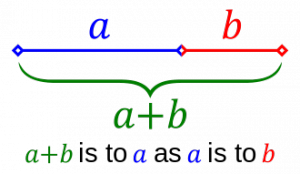Golden Ratio: Difference between revisions
No edit summary |
|||
| Line 7: | Line 7: | ||
The golden ratio also is called the golden mean or golden section. Other names include extreme and mean ratio, medial section, divine proportion, divine section , golden proportion, golden cut, and golden number.<ref>[http://en.wikipedia.org/wiki/Golden_ratio]</ref> | The golden ratio also is called the golden mean or golden section. Other names include extreme and mean ratio, medial section, divine proportion, divine section , golden proportion, golden cut, and golden number.<ref>[http://en.wikipedia.org/wiki/Golden_ratio]</ref> | ||
==Golden Ratio in Renaissance Art== | |||
In 1509, Luca Pacioli wrote a book that refers to the number as the "Divine Proportion," which was illustrated by Leonardo da Vinci. Da Vinci later called this sectio aurea or the Golden section. The Golden ratio was used to achieve balance and beauty in many Renaissance paintings and sculptures. Da Vinci himself used the Golden ratio to define all of the proportions in his Last Supper, including the dimensions of the table and the proportions of the walls and backgrounds. The Golden ratio also appears in da Vinci's Vitruvian Man and the Mona Lisa. Other artists who employed the Golden ratio include Michelangelo, Raphael, Rembrandt, Seurat, and Salvador Dali.<ref>[http://www.livescience.com/37704-phi-golden-ratio.html Live Science]</ref> | |||
Revision as of 19:30, 24 January 2016
In mathematics, two quantities are in the golden ratio if their ratio is the same as the ratio of their sum to the larger of the two quantities. The figure on the right illustrates the geometric relationship.
Phi is also used as a symbol for the Golden Ratio and on other occasions in math and science. This use is separately encoded as the Unicode glyph ϕ.
The golden ratio 1.618033988749894848204586834... in mathematics, art, and architecture.
The golden ratio also is called the golden mean or golden section. Other names include extreme and mean ratio, medial section, divine proportion, divine section , golden proportion, golden cut, and golden number.[1]
Golden Ratio in Renaissance Art
In 1509, Luca Pacioli wrote a book that refers to the number as the "Divine Proportion," which was illustrated by Leonardo da Vinci. Da Vinci later called this sectio aurea or the Golden section. The Golden ratio was used to achieve balance and beauty in many Renaissance paintings and sculptures. Da Vinci himself used the Golden ratio to define all of the proportions in his Last Supper, including the dimensions of the table and the proportions of the walls and backgrounds. The Golden ratio also appears in da Vinci's Vitruvian Man and the Mona Lisa. Other artists who employed the Golden ratio include Michelangelo, Raphael, Rembrandt, Seurat, and Salvador Dali.[2]


